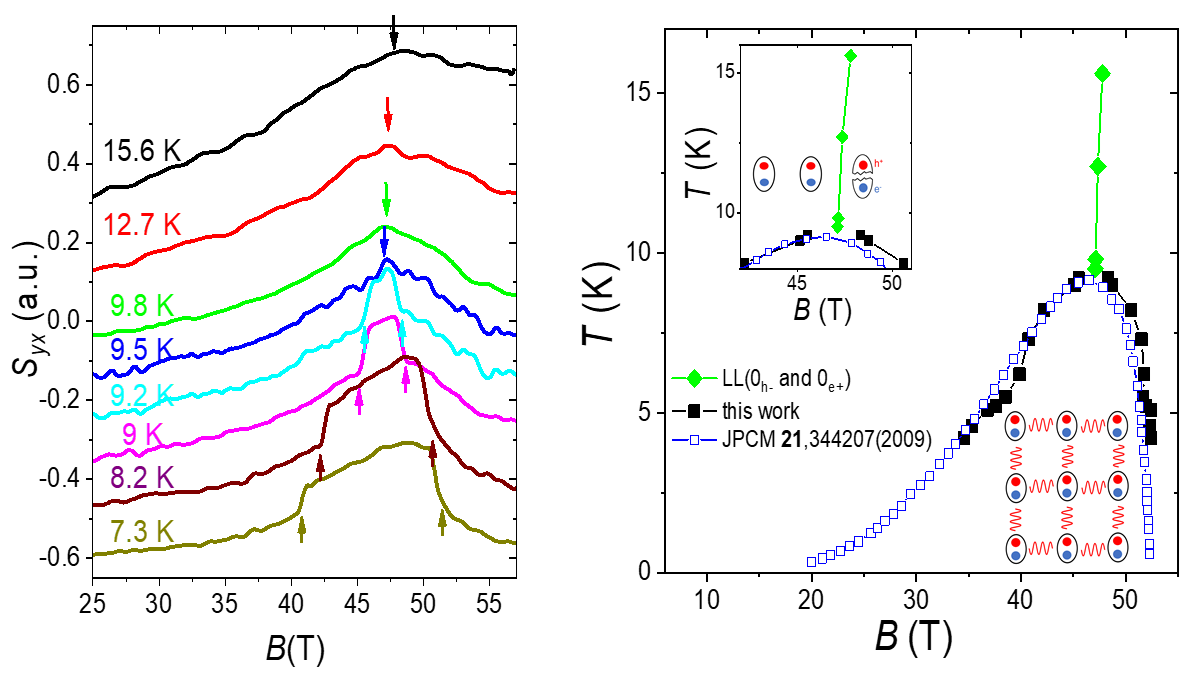
The field-dependence of Nernst signal of graphite around the critical point under pulsed field (left) and the phase diagram of Bose-Einstein condensation of excitons (right).
(PNAS 16, 2020; https://doi.org/10.1073/pnas.2012811117)
Background
An exciton is an electron-hole pair bound by attractive Coulomb interaction. Short-lived excitons have been detected by a variety of experimental probes in numerous contexts. An excitonic insulator, a collective state of such excitons has been more elusive. Theoretically, when the three -dimensional electrons are pushed beyond the quantum limit, it will bevulnerable to variousinstabilities like several density waves, excitonic insulator state and Wigner crystallization. However, few experimental cases are revealed, due to the insufficient low carrier density to reach the limit. Small carrier density and large binding energy of excitons make graphite theoptimized choiceto study the magnetic-field inducedBose-Einstein condensation of excitons.
What we discover?
Thanks to Nernst measurements in pulsed magnetic fields, we discover that in graphite there is a critical temperature (T = 9.2 K) and a critical magnetic field (B = 47 T) for Bose-Einstein condensation of excitons. At this critical field, hole and electron Landau sub-bands simultaneously cross the Fermi level and allow exciton formation. By quantifying the effective mass and the spatial separation of the excitons in the basal plane, we show that the degeneracy temperature of the excitonic fluid corresponds to this critical temperature. This identification would explain why the field-induced transition observed in graphite is not a universal feature of three-dimensional electron systems pushed beyond the quantum limit.
Why is this important?
Bose-Einstein condensation of excitons has become a dynamic field of research in the past couple of decades. Whilst individual excitons have been observed in many systems, a collective state of condensed excitons has proved to be more elusive. In this work, by quantifying the mass and the density of the electron-hole pairs, we identify a critical temperature of 9.2 K and a critical magnetic field of 47 T as the cradle of the Bose-Einstein condensation of excitons in graphite. Our identification radically revises the nature of the field-induced phase transition in graphite and its boundaries.
Why did we need WHMFC?
In this research, the phase transitions occur at ~20 T – 53 T, only the pulsed field can reach the condition. In WHMFC, the noise due to vibration can stay at a very low level to help us measure the transverse thermoelectricity effect-Nernst effect well.
Who did the research?
Jinhua Wang1, Pan Nie1, Xiaokang Li1, Huakun Zuo1, Benoît Fauqué2, Zengwei Zhu1,*, Kamran Behnia3
1 Wuhan National High Magnetic Field Center and School of Physics, Huazhong University of Science and Technology, Wuhan 430074, China
2JEIP, USR 3573 CNRS, Collège de France, PSL Research University, 11, place Marcelin Berthelot, 75231 Paris Cedex 05, France
3Laboratoirede Physique et d’Etude des Matériaux (CNRS), ESPCI Paris, PSL Research University, 75005 Paris, France
Funding
This work was supported by the National Key Research and Development Program of China (Grant no. 2016YFA0401704), the National Science Foundation of China (Grant nos.51861135104 and 11574097) and Fundamental Research Funds for the Central Universities (Grant no. 2019kfyXMBZ071). In France, it was supported by the Agence Nationale de la Recherche (ANR-18-CE92-0020-01; ANR-19-CE30-0014-04) and by Jeunes Equipes de l’Institut de Physique du Collège de France.
Link
https://doi.org/10.1073/pnas.2012811117
